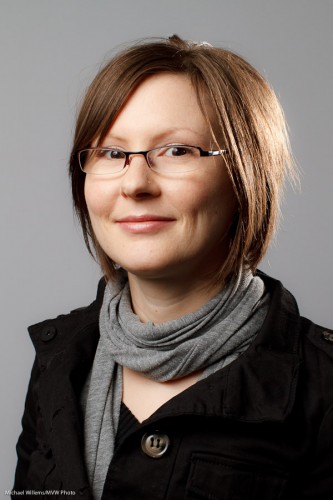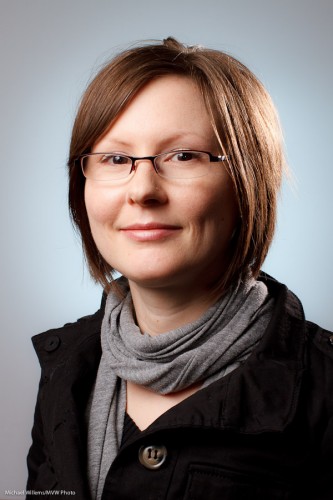When you shoot a studio portrait, you can use big studio lights – or small speedlights.
Because they are smaller and lighter, I tend to use small speedlights whenever I can.
And that does not mean compromising quality. Take this example. I took this shot of a very nice model and student during a course the other day, using TTL speedlights:
How is this done?
- One flash on a light stand into an umbrella (the “A”-flash), on our left. High enough to give us nice catch lights in the eyes, but no reflections in the glasses.
- The hairlight is one snooted speedlight (the “B”-flash) on the right (using a Honl photo snoot). I made sure this hairlight only lit of the hair, not the cheeks. That is what the snoot is for.
- I used a Canon 7D with a 50mm lens.
- I set the camera to manual, f/8, 1/200th second, 200 ISO. Normal settings for studio light. I made sure auto ISO was disabled.
- The flash was set to its normal TTL mode.
- I used flash compensation of, if I recall right, +1/3 stop.
- The “A:B ratio” was set to 3:1, meaning A was three times stronger than B.
I could have metered and used Pocketwizards and the flashes set to manual, and if I had done many portraits, I would have. But for a quick shot like this, I think TTL is a better way, since it is very quick. Indoors, wireless TTL is a no brainer, and it works: the on-camera flash, which is only used to direct the slave flashes, can be seen by any flash in the room. On a Nikon, or a Canon 7D or 60D, I need only the camera and its pop-up flash. On any other Canon, I would also need a 580EX flash on the camera, to direct the slaves.
But the portrait above is missing something, no? The background is a bit, well, bland.
So we add one more light, using a grid. And a gel. For the gel, I choose a complimentary colour: complimentary to the hair colour. So for brownish-reddish hair I use a beautiful blue-ish gel.
Now we get:
Better, no? Nice portrait, and it took only one light stand, one umbrella, three flashes, one grid, one gel, one 5″ snoot. All this is affordable, small, light.Professional portraits are now within reach of everyone.



Forgive me if I have missed the obvious, you stated in the equipment list that only one light stand was used. So I can’t help but wonder where the other two flashes were. Not on the camera, so where the floor? I am sure I will have a blonde moment when you answer, but it is not immediately obvious to me.
Thanks.
LW
I was hoping someone would ask. Hand held! Sometimes you (or a kind assistant) just hand hold a light… Simple is good.
I was acting as the lightstand for the hairlight! 🙂
And very professionally, if I may say so!
Thank you, at least it shows I am paying attention! I was thinking I could hold it with my left hand, but… my left hand is UNDER my lens.
Ex-ACT-ly!